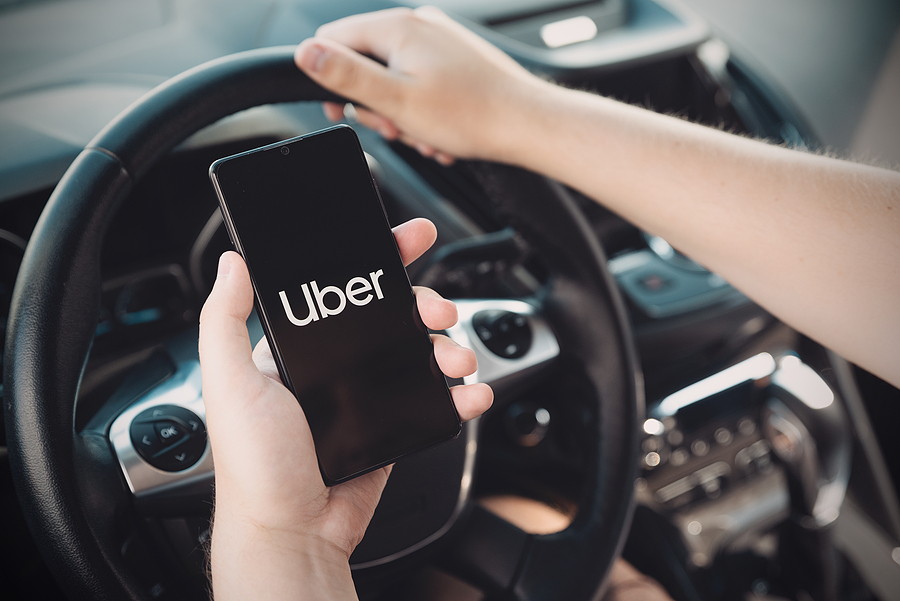Uber and Lyft dominate the ridesharing market. Together, they’ve made taxi cabs almost obsolete. Together, the two companies boast more than 150 million users each month.
But with more and more rideshare vehicles on the road, that increases the chances of accidents. Many of these can result in severe injuries and deaths. Victims often take action against the rideshare giants to obtain compensation for their injuries.

So, just how safe is it to get into an Uber, Lyft, or other rideshare vehicle? We’ll spell out the facts in this article. If you’re ever injured in a vehicle accident that wasn’t your fault – whether it involves rideshare or not – the attorneys with Sand Law will be ready to help you get the money you deserve. Please call 651-291-7263 or contact us online for a free consultation.
Ridesharing Accident Statistics
Obtaining comprehensive and up-to-date ridesharing accident statistics can be challenging, as the data is not always readily available or consistently reported by ridesharing companies or regulatory agencies. However, here are some general insights on ridesharing accident statistics based on available information:
- There were nearly 1,100 crashes involving Lyft and Uber drivers in Boston in 2021. This number made up nearly 25% of all accidents citywide.
- According to the University of Chicago researchers, the additional vehicles on the road due to Uber, Lyft, and other ridesharing services have increased car accident deaths by 3% across the country.
- But the news isn’t all bad. The University of Texas Health Science Center at Houston researchers looked at the relationship between Uber and DUI crashes in Houston between 2007-2019. They found that after Uber started service in the city, severe injuries decreased by nearly 24% on Friday and Saturday nights. DUI arrests also dropped significantly – by nearly 18% on Fridays and 15% on Saturdays.
Do Ridesharing Companies Run Background Checks?
Both Uber and Lyft perform criminal and driving background checks on prospective drivers. Drivers must submit to screenings regularly. These involve not only criminal checks but also motor vehicle records. Specific checks will vary depending on the city and state laws in which a driver operates. These are some of the reasons why both rideshare companies may deactivate a driver’s account:
- A felony conviction in the previous seven years.
- Any criminal convictions for serious offenses, including murder, kidnapping, sexual assault, and others.
- Pending serious criminal charges.
- Multiple accidents, moving violations or driving with a suspended license in the previous three years.
- Any serious moving violations in the previous seven years. Examples include reckless driving, DUI, and hit-and-run.
It’s important to note that while background checks are an essential safety measure, they aren’t foolproof. Some incidents or offenses may not appear in the records or may be missed due to limitations in the background check process. Ridesharing companies continue to refine their background check procedures to enhance passenger safety and maintain the integrity of their platforms.
Do Ridesharing Companies Fire Unsafe Drivers?
Technically, no. Instead of firing drivers, Uber and Lyft “deactivate” them or shut off access to their accounts. Deactivation happens for many reasons. Unsafe driving is one of them, as is driving under the influence of alcohol or drugs. Uber will also deny drivers access to rides for six hours if a passenger reports driving while drowsy.
Is Ridesharing Safe in 2023?
For the most part, ridesharing is safe. Nearly 100% of all Uber and Lyft trips end without any major safety issues. These are a few of the reasons why.
Driver Screening
Ridesharing companies typically conduct background checks on their drivers, including criminal records and driving history. This helps to ensure that drivers meet specific safety standards.
In-App Features
Ridesharing apps often have safety features, such as driver identification, real-time GPS tracking, and the ability to share your trip details with friends or family. These features can help increase your sense of security during your ride.
Ratings and Reviews
Uber and Lyft allow passengers to rate and review drivers and vice versa. This feedback system encourages accountability and helps maintain quality and safety within the service. Before accepting a ride, you can review the driver’s ratings and comments from other passengers.
Tips for Feeling Safe in an Uber or Lyft
Unfortunately, accidents do happen, even though the safety records of Uber and Lyft are, for the most part, impressive. Remember the following if you want to feel as comfortable as possible when in a rideshare vehicle.
Verify Driver and Vehicle Details
Before entering the vehicle, confirm that the driver and the car match the information provided in the app. Check the driver’s name, photo, and license plate number. This helps ensure you get into the right vehicle with the intended driver.
Share Trip Details
Use the “Share Trip” feature within the app to send your ride details, including the driver’s information, vehicle details, and real-time GPS tracking, to a friend or family member. This provides an extra layer of security by letting someone know about your journey.
Wear Seatbelts
Always buckle up for your safety. It’s a simple yet essential precaution that can protect you in case of an accident.
Steps to Take if You’re Involved in a Ridesharing Accident
If you’re involved in a ridesharing accident, taking the following steps can ensure your safety and protect your interests.
Ensure Your Safety
Prioritize your safety and the well-being of others involved in the accident. Call 911 immediately if you or anyone else requires immediate medical attention.
Gather Information
Collect information from all parties involved in the accident. This includes the names, contact details, and insurance information of the drivers, as well as the license plate numbers and vehicle descriptions. If there are any witnesses, try to obtain their contact information.
Document the Scene
Take pictures or videos of the accident scene, the damage to the vehicles involved, and any visible injuries. These visual records can serve as valuable evidence later on.
Seek Legal Advice
Consult with an attorney experienced in handling ridesharing accidents. They can guide you on your legal rights and options, such as navigating insurance claims and seeking appropriate compensation for any injuries or damages.
Preserve Evidence
Keep all relevant documents related to the accident, such as medical reports, receipts for medical expenses, and any communication with the ridesharing company or insurance providers. These documents will be critical in building your case.
Follow Medical Treatment
If you sustain any injuries, follow the advice and treatment plan medical professionals provide. Attend all necessary appointments and keep records of your medical treatments, including medications and therapies received.
Contact Sand Law to Schedule a Free Case Evaluation
A Sand Law attorney will work to help you obtain maximum compensation if you suffer an injury in a rideshare accident. Contact us online or call 651-291-7263 for a free evaluation of your case.

